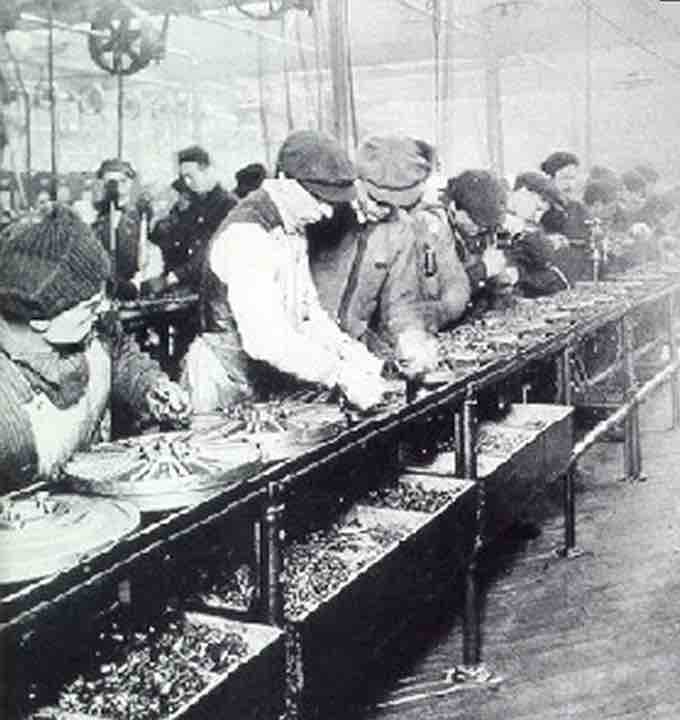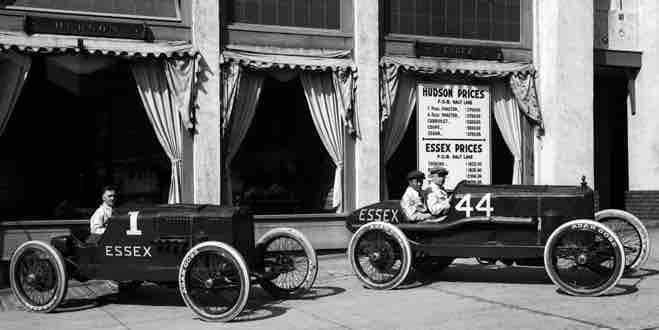The 1920s can be viewed as a period of great industrial production in America. The automobile, petroleum, steel, and chemical industries skyrocketed in their production during this period. This was largely due to the adoption by industry of the technique of mass production, the system under which identical products were churned out quickly and inexpensively using assembly lines. The changeover to mass production drove down prices for objects that were previously made in much more individual, time-consuming methods and subsequently enabled an increase in new, affordable technology. Meanwhile, technological advances in electrical recording created new entertainment mediums including radio and film, which became widespread and highly profitable. A middle class of Americans emerged in the postwar period with surplus money and a desire to spend more, spurring the demand for consumer goods, especially the car.
In the Air and On the Road
The widespread adoption of heavier-than-air, powered aircrafts had become practical for reconnaissance, artillery spotting and even attacks against ground positions during World War I. After the war, Charles Lindbergh rose to instant fame in 1927 with the first solo, non-stop transatlantic flight from Long Island, New York, to Paris, France. The global attention garnered by the achievement of 25-year-old "Lucky Lindy" spawned advances that led to commercial aviation in the next decade. In the late 1920s and early 1930s, Lindbergh used his fame to promote the development of both commercial aviation and Air Mail services in the United States and the Americas.
Charles Lindbergh
Famed aviator Charles "Lucky Lindy" Lindbergh made the first solo, nonstop transatlantic flight in 1927 at age 25.
Throughout the 1920s the automobile industry became one of chief importance as car manufacturing in the United States experienced extraordinary growth. Before the war, cars were a luxury, but in the 1920s mass-produced vehicles became common throughout the country. Using the manufacturing assembly line system, in which individual parts or sets of pieces are added to a product at stations on a conveyor belt or other moveable line, entrepreneurs such as automobile tycoon Henry Ford were able to greatly increase productivity. This innovation significantly reduced the cost of automobiles and thereby increased consumer demand.

Ford Assembly Line, 1913
Assembly lines revolutionized manufacturing in the first decades of the 20th Century.
Industries related to the manufacturing and use of automobiles grew. Demand increased for petroleum, steel and glass, leading to additional growth and profitability in these sectors. The auto industry's effectiveness and growth caused a ripple effect through driving-related industries such as highway construction and petroleum. In 1920, the United States produced 65% of the world's oil. State government contracts to build highways and roads in rural areas increased as new housing sprung up outside the range of mass transit.
Cars began to alter the American lifestyle and by 1929 one out of every five Americans owned one. Automobile dealers introduced the installment plan, a financing concept adopted in many other parts of business, while many used car dealerships opened. Gas stations and motels appeared around the country and the idea of "homes on wheels" became popular around this time, with Americans packing up food and camping equipment in order to get away for a while.

Essex race cars on display in Salt Lake City, 1920
Automobile manufacturing and popularity greatly increased in the 1920s.
Infrastructure Improvements and Debt
After a decline during the war, electrification progressed greatly in the 1920s as more of the United States was added to the electrical grid. Most industries switched from coal power to electricity and new power plants were constructed. Telephone lines were strung across the continent, and indoor plumbing and modern sewer systems were installed for the first time in many regions.
These infrastructure programs were mostly left to local governments, many of which went deeply into debt under the assumption that an investment in infrastructure would pay off in the future, a theory that caused major problems during the Great Depression. The federal government, meanwhile, employed the opposite strategy, using the decade of the 1920s to pay down war debts and roll back some taxes that had been introduced during the conflict but were no longer necessary to pay for mobilization and the demands of a war economy.
The Rise of Radio
Radio became the first mass broadcasting medium during the 1920s. Radio sets were initially expensive but the medium of entertainment and information transmission proved revolutionary. Radio advertising became the grandstand for mass marketing and its economic importance led to the mass culture that has dominated society since. During the "golden age of radio", programming was varied in a manner similar to television programming today. The establishment of the Federal Radio Commission in 1927 introduced a new era of regulation, ensuring the government played a role in the growth and oversight of the industry.
In 1925, electrical recording, one of the greatest advances in sound recording, became available for commercially issued phonograph records, spreading music to the masses along with recorded speeches and other forms of audio diversion. Hollywood also boomed, producing a new form of entertainment that shut down the old Vaudeville theatres – the silent film. Watching a movie was cheap and accessible, creating a profitable market that saw crowds surging into new downtown movie palaces and neighborhood theaters. Even greater entertainment marvels emerged as the decade progressed, the most important being sound synchronized motion pictures, or "talkies," which quickly replaced silent films between 1927 and 1929.
Safety Last!
The famous clock scene from the popular 1923 silent film, Safety Last!